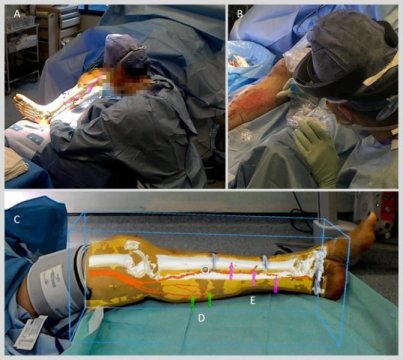05 Feb HoloLens Uses Mixed Reality To Facilitate Reconstruction in Trauma Patients
MedicalResearch.com Interview with:
Dr. Dimitri Amiras, FRCR
Consultant radiologist
Imperial College Healthcare NHS Trust
Dr. Philip Pratt PhD
Research Fellow
Department of Surgery & Cancer
Imperial College London at St Mary’s Hospital
MedicalResearch.com: What is the background for this study? What are the main findings?
Response: We have used the Microsoft HoloLens to assist with complex reconstructive surgery on several patients at a major trauma centre at St Marys Hospital. We believe this is the first report of such a use in reconstructive surgery.
From dedicated CT scans we have been able to construct patient specific 3D models of the vascular channels supplying the skin to help the surgeon plan their surgical approach for the harvest of these skin flaps. These 3D models are then projected onto the patient as holograms using the Microsoft HoloLens making the information available and directly relevant at the time of the procedure.
The technique helps the surgeon in planning his approach for the patient as well saving time locating the correct vessels at the time of surgery.
MedicalResearch.com: What should readers take away from your report?
Response: The application of this technology is achievable in a clinical environment and has potential to improve clinical outcomes. This would only have been possible by working closely as a team, involving computer scientists, radiologists and reconstructive surgeons. In this way this piece of work is a good example of translating technology into better patient care.
MedicalResearch.com: What recommendations do you have for future research as a result of this work?
Response: We recommend that larger studies looking at different medical applications. From a technical aspect more accurate motion tracking is a field for development allowing the hologram to automatically and accurately track to a limb or other part of the anatomy. We would also like to reduce the process steps involved in getting to the holographic models.
MedicalResearch.com: Is there anything else you would like to add?
Response: This piece of work would only have been possible with Imperial College NHS Trust working as a partner in Imperial College Academic Health Science Centre.
Citations:
Philip Pratt, Matthew Ives, Graham Lawton, Jonathan Simmons, Nasko Radev, Liana Spyropoulou, Dimitri Amiras. Through the HoloLens™ looking glass: augmented reality for extremity reconstruction surgery using 3D vascular models with perforating vessels. European Radiology Experimental, 2018; 2 (1) DOI: 1186/s41747-017-0033-2
[wysija_form id=”3″]
The information on MedicalResearch.com is provided for educational purposes only, and is in no way intended to diagnose, cure, or treat any medical or other condition. Always seek the advice of your physician or other qualified health and ask your doctor any questions you may have regarding a medical condition. In addition to all other limitations and disclaimers in this agreement, service provider and its third party providers disclaim any liability or loss in connection with the content provided on this website.
Last Updated on February 5, 2018 by Marie Benz MD FAAD

